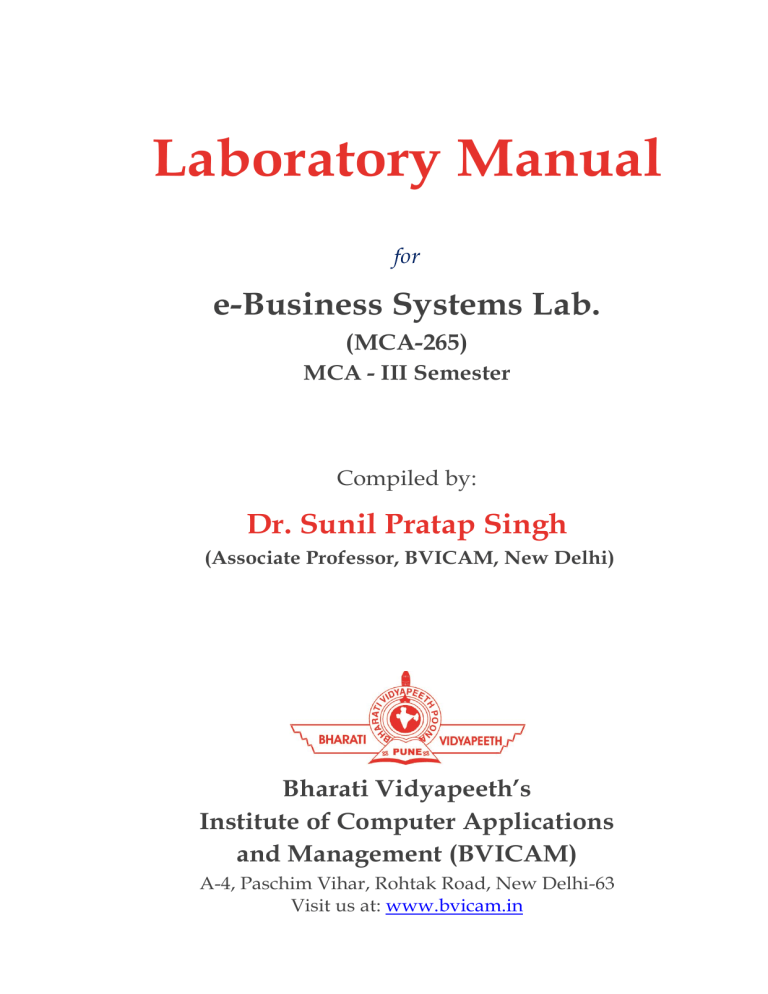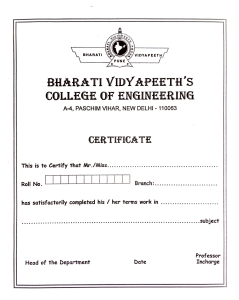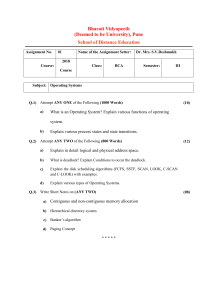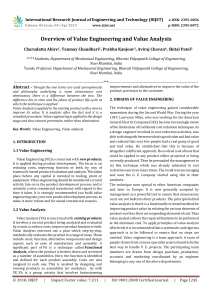
Laboratory Manual for e-Business Systems Lab. (MCA-265) MCA - III Semester Compiled by: Dr. Sunil Pratap Singh (Associate Professor, BVICAM, New Delhi) Bharati Vidyapeeth’s Institute of Computer Applications and Management (BVICAM) A-4, Paschim Vihar, Rohtak Road, New Delhi-63 Visit us at: www.bvicam.in Laboratory Manual for MCA-265; e-Business Systems Lab. Index List of Abbreviations Declaration 1. Vision of the Department 4 2. Mission of the Department 4 3. Programme Educational Objectives (PEOs) 4 4. Programme Outcomes (POs) 5 5. Institutional Policy for Students’ Conduct 7 6. Learning Outcomes of Laboratory Work 8 7. Course/Lab Outcomes (COs) 9 8. Mapping of COs with POs 9 9. Course/Lab Description 9 10. Grading Policy 10 11. Lesson Plan 10 12. Lab Exercises/Problems 11 Appendix – A (Index of Lab File) 14 © Bharati Vidyapeeth’s Institute of Computer Applications and Management (BVICAM), New Delhi | Page 2 of 14 Laboratory Manual for MCA-265; e-Business Systems Lab. List of Abbreviations BTL Bloom’s Taxonomy Level CE Communication Efficacy CICP Conduct Investigations of Complex Computing Problems CK Computational Knowledge CO Course Outcome DAC Departmental Advisory Committee DDS Design and Development of Solutions I&E Innovation and Entrepreneurship I&T Individual & Team Work IQAC Internal Quality Assurance Cell LLL Life-Long Learning MTU Modern Tool Usage PA Problem Analysis PE Professional Ethics PEO Programme Educational Objective PMF Project Management and Finance PO Programme Outcome SEC Societal and Envoirnmental Concern SED Stream Editor © Bharati Vidyapeeth’s Institute of Computer Applications and Management (BVICAM), New Delhi | Page 3 of 14 Laboratory Manual for MCA-265; e-Business Systems Lab. Declaration Department : Department of Computer Science and Applications Course, Year and the Semester to which Lab is offered : MCA - II Year, III Semester Name of the Lab Course : e-Business Systems Lab. Course Code : MCA-265 (Lab. based on Core Elective – II) Version No. : Name of Course/Lab Teacher : Dr. Sunil Pratap Singh Laboratory Manual Committee : 1. Dr. Ritika Wason 2. Prof. P. S. Grover 3. Mr. Amit Sharma, Alumni & Industry Expert 4. Dr. Sunil Pratap Singh Approved by : DAC Approved by : IQAC Signature (Course Teacher) Signature (Head of Department) Signature (IQAC Coordinator) © Bharati Vidyapeeth’s Institute of Computer Applications and Management (BVICAM), New Delhi | Page 4 of 14 Laboratory Manual for MCA-265; e-Business Systems Lab. 1. Vision of the Department To become a centre of excellence in the field of Computer Science and Applications to produce quality professionals in software development. 2. Mission of the Department M1 To produce quality software professionals as per global industry standards. M2 To foster innovation, entrepreneurial skills, research capabilities and bring all-round development amongst budding professionals. M3 To promote analytical and collaborative life-long learning skills, among students and faculty members. M4 To inculcate strong ethical values and professional behaviour while giving equal emphasis to social commitment and nation building. 3. Programme Educational Objectives (PEOs) The PEO’s for the MCA programme are as follows: PEO1 Exhibit professional competencies and knowledge for being a successful technocrat. PEO2 Adopt creative and innovative practices to solve real-life complex problems. PEO3 Be a lifelong learner and contribute effectively to the betterment of the society. PEO4 Be effective and inspiring leader for fellow professionals and face the challenges of the rapidly changing multi-dimensional, contemporary world. © Bharati Vidyapeeth’s Institute of Computer Applications and Management (BVICAM), New Delhi | Page 5 of 14 Laboratory Manual for MCA-265; e-Business Systems Lab. 4. Programme Objectives (POs) PO1: Computational Knowledge (CK) Demonstrate competencies in fundamentals of computing, computing specialisation, mathematics, and domain knowledge suitable for the computing specialisation to the abstraction and conceptualisation of computing models from defined problems and requirements. PO2: Problem Analysis (PA) Identify, formulate, and analyze complex real-life problems in order to arrive at computationally viable conclusions using fundamentals of mathematics, computer sciences, management and relevant domain disciplines. PO3: Design and Development of Solutions (DDS) Design efficient solutions for complex, real-world problems to design systems, components or processes that meet the specifications with suitable consideration to public health, and safety, cultural, societal, and environmental considerations. PO4: Conduct Investigations of Complex Computing Problems (CICP) Ability to research, analyze and investigate complex computing problems through design of experiments, analysis and interpretation of data, and synthesis of the information to arrive at valid conclusions. PO5: Modern Tool Usage (MTU) Create, select, adapt and apply appropriate technologies and tools to a wide range of computational activities while understanding their limitations. PO6: Professional Ethics (PE) Ability to perform professional practices in an ethical way, keeping in mind cyber regulations & laws, responsibilities, and norms of professional computing practices. © Bharati Vidyapeeth’s Institute of Computer Applications and Management (BVICAM), New Delhi | Page 6 of 14 Laboratory Manual for MCA-265; e-Business Systems Lab. PO7: Life-Long Learning (LLL) Ability to engage in independent learning for continuous selfdevelopment as a computing professional. PO8: Project Management and Finance (PMF) Ability to apply knowledge and understanding of the computing and management principles and apply these to one’s own work, as a member and leader in a team, to manage projects in multidisciplinary environments. PO9: Communication Efficacy (CE) Ability to effectively communicate with the technical community, and with society at large, about complex computing activities by being able to understand and write effective reports, design documentation, make effective presentations, with the capability of giving and taking clear instructions. PO10: Societal and Envoirnmental Concern (SEC) Ability to recognize and assess societal, environmental, health, safety, legal, and cultural issues within local and global contexts, and the consequential responsibilities applicable to professional computing practices. PO11: Individual & Team Work (I&T) Ability to work in multi-disciplinary team collaboration both as a member and leader as per need. PO12: Innovation and Entrepreneurship (I&E) Ability to apply innovation to track a suitable opportunity to create value and wealth for the betterment of the individual and society at large. © Bharati Vidyapeeth’s Institute of Computer Applications and Management (BVICAM), New Delhi | Page 7 of 14 Laboratory Manual for MCA-265; e-Business Systems Lab. 5. Institutional Policy for Students’ Conduct The following guidelines shall be followed:5.1 All the students in their introductory Lab. shall be assigned a system, which shall be their workplace for the complete semester. Students can store records of all their Lab. assignments on their individual workstations. 5.2 Introductory Lab. shall include an introduction to the appropriate software/tool, followed by a basic Introductory Assignment having Practice Questions. All the students are expected to complete this assignment within a week time, as the same shall be assessed through a lab. test. 5.3 Each week, the instructor, in parallel to respective topics covered in the theory lecture, shall assign a set of practical problems to the students. The problems in these assignments shall be divided into two parts. The first set of problems shall be compulsory for all the students and its record need to be maintained in the Prcatical File, having prescribed format, as given in Appendix - A. All the students should get the Practical File checked and signed, weekly, by the respective teacher. The second set of problems is Advanced Problems and shall be optional. Student may solve these advanced problems for their further practice. 5.4 Cellular phones, pagers, CD players, radios and similar devices are prohibited in the classrooms, laboratories and examination halls. 5.5 Laptops, Tablets may be used in lectures/labs for the purpose of taking notes or working on team-projects. 5.6 The internal practical exam shall be conducted towards the end of the semester and shall include the complete set of lab exercises conducted as per syllabus. However, students shall be assessed on continuos basis through overall performances in regular lab. tests, both announced and surprise and viva-voce. 5.7 The respective faculty shall prepare and submit sufficient number of practical sets of computing problems to the Dean (Examinations), atleast two © Bharati Vidyapeeth’s Institute of Computer Applications and Management (BVICAM), New Delhi | Page 8 of 14 Laboratory Manual for MCA-265; e-Business Systems Lab. weeks prior to the actual exam. It is the responsibility of the faculty to ensure that a set should not be repeated for more than 5 students in a given batch. 5.8 The internal practical exam shall be of 3 hours duration where the student shall be expected to implement solutions to his/her assigned set of problems on appropriate software tools in the lab. 5.9 Once implemented, student shall also appropriately document code implemented in the assigned answer sheets, which shall be submitted at the end of the examination. All the students shall also appear for viva-voce examination during the exam. 5.10 Co-operate, collaborate and explore for the best individual learning outcomes but copying or entering into the act of plagiarism is strictly prohibited. 6. Learning Outcomes of Laboratory Work The student shall demonstrate the ability to: Verify and Implement the concepts and theory learnt in class. Code and use Software Tools to solve problems and present their optimal solutions. Apply numerical/statistical formulas for solving problems/questions. Develop and apply critical thinking skills. Design and present Lab as well as project reports. Apply appropriate methods for the analysis of raw data. Perform logical troubleshooting as and when required. Work effectively as a member of a team in varying roles as need be. Communicate effectively, both oral and written. Cultivate ethics, social empathy, creativity and entrepreneurial mindset. © Bharati Vidyapeeth’s Institute of Computer Applications and Management (BVICAM), New Delhi | Page 9 of 14 Laboratory Manual for MCA-265; e-Business Systems Lab. 7. Course/Lab Outcomes (COs) CO1 Model an appropriate business model for a proposed website. [BTL3] CO2 Distinguish varied online payment methods. [BTL4] CO3 Assess varied e-commerce software. [BTL5] CO4 Create an e-commerce website and compare it with similar existing websites. [BTL6] 8. Mapping of CO’s with PO’s Table 1: Mapping of CO’s with PO’s PO/CO PO1 PO2 PO3 PO4 PO5 PO6 PO7 PO8 PO9 PO10 PO11 PO12 CO1 ✓ ✓ ✓ CO2 ✓ ✓ ✓ ✓ ✓ CO3 ✓ ✓ ✓ ✓ ✓ ✓ CO4 ✓ ✓ ✓ ✓ ✓ ✓ ✓ ✓ ✓ ✓ ✓ ✓ ✓ 9. Course/Lab Description Course (Lab) Title : e-Business Systems Lab. Course (Lab) Code : MCA-265 (Lab. based on Core Elective – II) Credits : 01 Pre-requisites : Basics of Computers, Basics of Online Applications, Business Concepts Academic Session : July to December Contact Hours/Week : 02 (01 Labs of 02 Hours/Week) Internal Assessment : 40 Marks External Assessment : 60 Marks © Bharati Vidyapeeth’s Institute of Computer Applications and Management (BVICAM), New Delhi | Page 10 of 14 Laboratory Manual for MCA-265; e-Business Systems Lab. 10. Grading Policy Item Points Marks 10 10 Closed Book/Open Book 20 10 Closed Book Viva-Voce 20 20 Closed Book External End-Term 60 60 Closed Book (conducted and Weekly Lab Exercises Remarks including Practical Files Internal End-Term Practical Examination Examinations evaluated by the University) Total 100 11. Lesson Plan Week No. Lab No. Topics/Concepts to be Covered 1. 1. E-Commerce Portals 2. 2. E-Commerce Models 3. 3. Electronic Payment System 4. 4. Electronic Fund Transfer 5. 5. Web Based Tools and Software for E-Commerce 6. 6. Buffer Reserved for Revision 7. 7. Development of a New Portal of any other relevant ECommerce Portal 8. 8. Development of a New Portal of any other relevant ECommerce Portal (continued) 9. 9. Development of a New Portal of any other relevant ECommerce Portal (continued) 10. 10. Development of a New Portal of any other relevant ECommerce Portal (continued) 11. 11. Development of a New Portal of any other relevant ECommerce Portal (continued) 12. 12. Buffer Reserved for Revision © Bharati Vidyapeeth’s Institute of Computer Applications and Management (BVICAM), New Delhi | Page 11 of 14 Laboratory Manual for MCA-265; e-Business Systems Lab. 12. Lab Exercises/Problems P1 Suppose you want to develop an educational website to offer question papers of examinations of various courses, plan an appropriate business model through which revenue can be generated. [CO1/BTL3] P2 Illustrate the working of following payment methods: [CO2/BTL4] a) Debit card b) Digital wallet c) Direct debit d) UPI e) Net banking P3 Access and compare the following e-commerce portals in terms of their business models and revenue models: [CO3/BTL3] a) www.indiamart.com and www.amazon.in b) www.bestprice.in and www.flipkart.com c) www.policybazaar.com and www.bookmyshow.com d) www.makemytrip.com and www.carwale.com P4 Assess the following e-commerce software/platforms for their merits and demerits: [CO3/BTL5] a) WooCommerce b) Shopify c) Magento d) BigCommerce e) Ecwid f) Salesforce Commerce Cloud g) Oracle Commerce h) Drupal Commerce. P5 Create a news portal to displays different categories of news (Sports, Political, Bollywood, Healthcare, etc.) in different languages (Hindi, English, Punjabi, etc.) by implementing any one of the following revenue models: Fee-for-Content Revenue Model Advertising-Supported Revenue Model © Bharati Vidyapeeth’s Institute of Computer Applications and Management (BVICAM), New Delhi | Page 12 of 14 Laboratory Manual for MCA-265; e-Business Systems Lab. The portal should demonstrate the working of administrator (managing news and users) and user (subscribing news of his/her interest and read/comment news). If fee-for-content revenue model is implemented, the subscription fee may be different for different type categories of news. If advertising-supported revenue model is implemented, the advertisement display price of different ads may vary for different categories of news. [CO4/BTL6]. © Bharati Vidyapeeth’s Institute of Computer Applications and Management (BVICAM), New Delhi | Page 13 of 14 Laboratory Manual for MCA-265; e-Business Systems Lab. Appendix – A: Index of Lab File Week Lab. No. Ex. No. Detailed Description of the Lab Exercise Outcome Page No./Link Mapping of Online Document CO BTL Signature of Teacher with Date 1 2 3 4 5 6 7 8 9 10 Note: The students should use header and footer, mentioning their roll number & name in header and page number in footer. © Bharati Vidyapeeth’s Institute of Computer Applications and Management (BVICAM), New Delhi | Page 14 of 14




